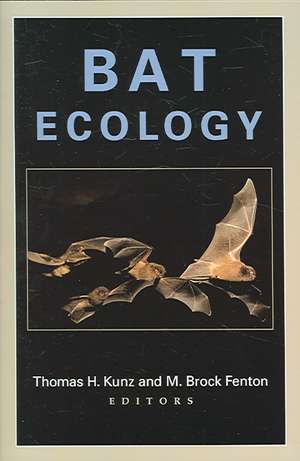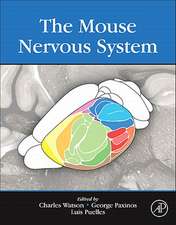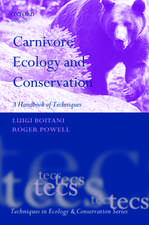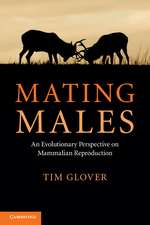Bat Ecology
Editat de Thomas H. Kunz, M. Brock Fentonen Limba Engleză Paperback – 12 dec 2005
In recent years researchers have discovered that bats play key roles in many ecosystems as insect predators, seed dispersers, and pollinators. Bats also display astonishing ecological and evolutionary diversity and serve as important models for studies of a wide variety of topics, including food webs, biogeography, and emerging diseases. In Bat Ecology, world-renowned bat scholars present an up-to-date, comprehensive, and authoritative review of this ongoing research.
The first part of the book covers the life history and behavioral ecology of bats, from migration to sperm competition and natural selection. The next section focuses on functional ecology, including ecomorphology, feeding, and physiology. In the third section, contributors explore macroecological issues such as the evolution of ecological diversity, range size, and infectious diseases (including rabies) in bats. A final chapter discusses conservation challenges facing these fascinating flying mammals.
Bat Ecology is the most comprehensive state-of-the-field collection for scientists and researchers.
Contributors:
John D. Altringham, Robert M. R. Barclay, Tenley M. Conway, Elizabeth R. Dumont, Peggy Eby, Abigail C. Entwistle, Theodore H. Fleming, Patricia W. Freeman, Lawrence D. Harder, Gareth Jones, Linda F. Lumsden, Gary F. McCracken, Sharon L. Messenger, Bruce D. Patterson, Paul A. Racey, Jens Rydell, Charles E. Rupprecht, Nancy B. Simmons, Jean S. Smith, John R. Speakman, Richard D. Stevens, Elizabeth F. Stockwell, Sharon M. Swartz, Donald W. Thomas, Otto von Helversen, Gerald S. Wilkinson, Michael R. Willig, York Winter
The first part of the book covers the life history and behavioral ecology of bats, from migration to sperm competition and natural selection. The next section focuses on functional ecology, including ecomorphology, feeding, and physiology. In the third section, contributors explore macroecological issues such as the evolution of ecological diversity, range size, and infectious diseases (including rabies) in bats. A final chapter discusses conservation challenges facing these fascinating flying mammals.
Bat Ecology is the most comprehensive state-of-the-field collection for scientists and researchers.
Contributors:
John D. Altringham, Robert M. R. Barclay, Tenley M. Conway, Elizabeth R. Dumont, Peggy Eby, Abigail C. Entwistle, Theodore H. Fleming, Patricia W. Freeman, Lawrence D. Harder, Gareth Jones, Linda F. Lumsden, Gary F. McCracken, Sharon L. Messenger, Bruce D. Patterson, Paul A. Racey, Jens Rydell, Charles E. Rupprecht, Nancy B. Simmons, Jean S. Smith, John R. Speakman, Richard D. Stevens, Elizabeth F. Stockwell, Sharon M. Swartz, Donald W. Thomas, Otto von Helversen, Gerald S. Wilkinson, Michael R. Willig, York Winter
Preț: 463.48 lei
Nou
Puncte Express: 695
Preț estimativ în valută:
88.68€ • 92.59$ • 73.40£
88.68€ • 92.59$ • 73.40£
Carte tipărită la comandă
Livrare economică 05-19 aprilie
Preluare comenzi: 021 569.72.76
Specificații
ISBN-13: 9780226462073
ISBN-10: 0226462072
Pagini: 798
Ilustrații: 19 halftones, 112 line drawings, 28 tables
Dimensiuni: 152 x 229 x 53 mm
Greutate: 1.06 kg
Editura: University of Chicago Press
Colecția University of Chicago Press
ISBN-10: 0226462072
Pagini: 798
Ilustrații: 19 halftones, 112 line drawings, 28 tables
Dimensiuni: 152 x 229 x 53 mm
Greutate: 1.06 kg
Editura: University of Chicago Press
Colecția University of Chicago Press
Notă biografică
Thomas H. Kunz (1938–2020) was professor of biology and director of the Center for Ecology and Conservation Biology at Boston University. He is coeditor, most recently, of Bat Biology and Conservation. M. Brock Fenton is a professor of biology at York University. He is the author of, among other books, The Bat: Wings in the Night Sky and Bats, revised edition.
Cuprins
Preface
PART I. LIFE HISTORY AND SOCIAL BIOLOGY
1. Ecology of Cavity and Foliage Roosting Bats
Thomas H. Kunz and Linda F. Lumsden
Introduction
Types of Roosts
Morphological and Behavioral Adaptations for Roosting
Colony Size
Roost Fidelity
Influence of Roost Selection on Social Organization and Mating Systems
Relationships between Roosting and Foraging Behavior
Conservation of Cavity and Foliage Roosting Bats
Acknowledgments
Literature Cited
2. Sensory Ecology and Communication in the Chiroptera
John D. Altringham and M. Brock Fenton
Introduction
Seven Species
The Senses
Sound: Echolocation to Communication
Multimodal Communication
Mother-Young Communication
Some Challenges
Acknowledgments
Literature Cited
3. Bats and Balls: Sexual Selection and Sperm Competition in the Chiroptera
Gerald S. Wilkinson and Gary F. McCracken
Introduction
Methods
Results
Discussion
Acknowledgments
Literature Cited
4. Ecology of Bat Migration
Theodore H. Fleming and Peggy Eby
Introduction
Definition of Migration
Why Migrate?
Who Migrates?
Physiological Consequences of Migration
Life History, Social, Population Genetic, and Community Consequences of Migration
Conservation Consequences of Migration
Basic Differences between the Migratory Ecology of Birds and Bats
Conclusions
Acknowledgments
Literature Cited
5. Life Histories of Bats: Life in the Slow Lane
Robert M. R. Barclay and Lawrence D. Harder
Introduction
Life-History Data
Life Histories of Bats
The Unique Biology of Bats
Testing Hypotheses regarding Life-History Evolution
The Consequences of Polyovulation for Life-History Variation among Bats
The Fast-Slow Continuum among Bats
Scenario for the Evolution of Bat Life Histories
Conclusions
Acknowledgments
Literature Cited
PART II. FUNCTIONAL ECOLOGY
6. Ecomorphology of Bats: Comparative and Experimental Approaches Relating Structural Design to Ecology
Sharon M. Swartz, Patricia W. Freeman, and Elizabeth F. Stockwell
Introduction
Correlational Approaches to Assessing Form and Its Ecological Significance
Function-Focused Approaches to Morphological Analysis
Computer Modeling Approaches in Ecomorphology
Phylogenetic Considerations in Ecomorphology
Conclusions
Acknowledgments
Literature Cited
7. Attack and Defense: Interactions between Echolocating Bats and Their Insect Prey
Gareth Jones and Jens Rydell
Introduction
Echolocation and Insectivory in Early Bats
Which Insects Are Eaten by Bats and When?
How Bats Detect and Capture Insects
Capture Success and Prey Selection
Insect Defenses against Bat Predation
Acknowledgments
Literature Cited
8. Glossophagine Bats and Their Flowers: Costs and Benefits for Plants and Pollinators
Otto von Helversen and York Winter
Introduction
How Flowers Are Made Conspicuous for Pollinating Bats
Energy and Food Resource Requirements
Scaling of Energy Expenditures and Community Assembly Rules
Evolution of Bat Pollination
Transitions between Pollination Systems
Loose Ends and Directions for Future Research
Acknowledgments
Literature Cited
9. Bats and Fruits: An Ecomorphological Approach
Elizabeth R. Dumont
Introduction
Fruits as Food
Patterns of Resource Use
Directions for Future Research
Acknowledgments
Literature Cited
10. Physiological Ecology and Energetics of Bats
John R. Speakman and Donald W. Thomas
Introduction
A Primer on Heat Flow, Metabolic Rate, and the Regulation of Body Temperature
Resting Energy Expenditure of Euthermic Bats
Regulation of Body Temperature and the Use of Torpor by Bats
Flight and the Energetic Costs of Locomotion
Estimating and Measuring Field Metabolic Rate in Bats
Acknowledgments
Literature Cited
PART III. MACROECOLOGY
11. Evolution of Ecological Diversity in Bats
Nancy B. Simmons and Tenley M. Conway
Introduction
Early Evolution of Bats
Evolution of Foraging Habits in Extant Families
Chiropteran Body Size
Evolution of Biogeographic Patterns
Discussion and Conclusions
Acknowledgments
Literature Cited
12. Trophic Strategies, Niche Partitioning, and Patterns of Ecological Organization
Bruce D. Patterson, Michael R. Willig, and Richard D. Stevens
Introduction
Conceptual Underpinnings and Terminology
Bat Ensembles and Their Characteristics
Broad-Scale Patterns in the Organization of Local Bat Assemblages and Ensembles
Overview and Prospectus
Acknowledgments
Literature Cited
13. Patterns of Range Size, Richness, and Body Size in the Chiroptera
Michael R. Willig, Bruce D. Patterson, and Richard D. Stevens
Introduction
Patterns of Species Range Size
Patterns of Species Richness
Patterns of Body Size
Overview
Acknowledgments
Literature Cited
14. Bats, Emerging Virus Infections, and the Rabies Paradigm
Sharon L. Messenger, Charles E. Rupprecht, and Jean S. Smith
Introduction
A Primer of Terms
Biological Attributes of Bats and Disease Facilitation
Bats and the Recent Emergence of New Viral Diseases
Disease Ecology in Bats: The Rabies Paradigm
Conclusions
Acknowledgments
Literature Cited
15. Conservation Ecology of Bats
Paul A. Racey and Abigail C. Entwistle
Introduction
Conservation Status of Bats
Threats to Bat Populations
Ecological Requirements of Bats
Development of Conservation Approaches
Epilogue
Acknowledgements
Literature Cited
List of Contributors
Author Index
Species Index
Subject Index
PART I. LIFE HISTORY AND SOCIAL BIOLOGY
1. Ecology of Cavity and Foliage Roosting Bats
Thomas H. Kunz and Linda F. Lumsden
Introduction
Types of Roosts
Morphological and Behavioral Adaptations for Roosting
Colony Size
Roost Fidelity
Influence of Roost Selection on Social Organization and Mating Systems
Relationships between Roosting and Foraging Behavior
Conservation of Cavity and Foliage Roosting Bats
Acknowledgments
Literature Cited
2. Sensory Ecology and Communication in the Chiroptera
John D. Altringham and M. Brock Fenton
Introduction
Seven Species
The Senses
Sound: Echolocation to Communication
Multimodal Communication
Mother-Young Communication
Some Challenges
Acknowledgments
Literature Cited
3. Bats and Balls: Sexual Selection and Sperm Competition in the Chiroptera
Gerald S. Wilkinson and Gary F. McCracken
Introduction
Methods
Results
Discussion
Acknowledgments
Literature Cited
4. Ecology of Bat Migration
Theodore H. Fleming and Peggy Eby
Introduction
Definition of Migration
Why Migrate?
Who Migrates?
Physiological Consequences of Migration
Life History, Social, Population Genetic, and Community Consequences of Migration
Conservation Consequences of Migration
Basic Differences between the Migratory Ecology of Birds and Bats
Conclusions
Acknowledgments
Literature Cited
5. Life Histories of Bats: Life in the Slow Lane
Robert M. R. Barclay and Lawrence D. Harder
Introduction
Life-History Data
Life Histories of Bats
The Unique Biology of Bats
Testing Hypotheses regarding Life-History Evolution
The Consequences of Polyovulation for Life-History Variation among Bats
The Fast-Slow Continuum among Bats
Scenario for the Evolution of Bat Life Histories
Conclusions
Acknowledgments
Literature Cited
PART II. FUNCTIONAL ECOLOGY
6. Ecomorphology of Bats: Comparative and Experimental Approaches Relating Structural Design to Ecology
Sharon M. Swartz, Patricia W. Freeman, and Elizabeth F. Stockwell
Introduction
Correlational Approaches to Assessing Form and Its Ecological Significance
Function-Focused Approaches to Morphological Analysis
Computer Modeling Approaches in Ecomorphology
Phylogenetic Considerations in Ecomorphology
Conclusions
Acknowledgments
Literature Cited
7. Attack and Defense: Interactions between Echolocating Bats and Their Insect Prey
Gareth Jones and Jens Rydell
Introduction
Echolocation and Insectivory in Early Bats
Which Insects Are Eaten by Bats and When?
How Bats Detect and Capture Insects
Capture Success and Prey Selection
Insect Defenses against Bat Predation
Acknowledgments
Literature Cited
8. Glossophagine Bats and Their Flowers: Costs and Benefits for Plants and Pollinators
Otto von Helversen and York Winter
Introduction
How Flowers Are Made Conspicuous for Pollinating Bats
Energy and Food Resource Requirements
Scaling of Energy Expenditures and Community Assembly Rules
Evolution of Bat Pollination
Transitions between Pollination Systems
Loose Ends and Directions for Future Research
Acknowledgments
Literature Cited
9. Bats and Fruits: An Ecomorphological Approach
Elizabeth R. Dumont
Introduction
Fruits as Food
Patterns of Resource Use
Directions for Future Research
Acknowledgments
Literature Cited
10. Physiological Ecology and Energetics of Bats
John R. Speakman and Donald W. Thomas
Introduction
A Primer on Heat Flow, Metabolic Rate, and the Regulation of Body Temperature
Resting Energy Expenditure of Euthermic Bats
Regulation of Body Temperature and the Use of Torpor by Bats
Flight and the Energetic Costs of Locomotion
Estimating and Measuring Field Metabolic Rate in Bats
Acknowledgments
Literature Cited
PART III. MACROECOLOGY
11. Evolution of Ecological Diversity in Bats
Nancy B. Simmons and Tenley M. Conway
Introduction
Early Evolution of Bats
Evolution of Foraging Habits in Extant Families
Chiropteran Body Size
Evolution of Biogeographic Patterns
Discussion and Conclusions
Acknowledgments
Literature Cited
12. Trophic Strategies, Niche Partitioning, and Patterns of Ecological Organization
Bruce D. Patterson, Michael R. Willig, and Richard D. Stevens
Introduction
Conceptual Underpinnings and Terminology
Bat Ensembles and Their Characteristics
Broad-Scale Patterns in the Organization of Local Bat Assemblages and Ensembles
Overview and Prospectus
Acknowledgments
Literature Cited
13. Patterns of Range Size, Richness, and Body Size in the Chiroptera
Michael R. Willig, Bruce D. Patterson, and Richard D. Stevens
Introduction
Patterns of Species Range Size
Patterns of Species Richness
Patterns of Body Size
Overview
Acknowledgments
Literature Cited
14. Bats, Emerging Virus Infections, and the Rabies Paradigm
Sharon L. Messenger, Charles E. Rupprecht, and Jean S. Smith
Introduction
A Primer of Terms
Biological Attributes of Bats and Disease Facilitation
Bats and the Recent Emergence of New Viral Diseases
Disease Ecology in Bats: The Rabies Paradigm
Conclusions
Acknowledgments
Literature Cited
15. Conservation Ecology of Bats
Paul A. Racey and Abigail C. Entwistle
Introduction
Conservation Status of Bats
Threats to Bat Populations
Ecological Requirements of Bats
Development of Conservation Approaches
Epilogue
Acknowledgements
Literature Cited
List of Contributors
Author Index
Species Index
Subject Index
Recenzii
“Bat Ecology presents the distilled wisdom of some of the world’s greatest bat experts. Covering far more than the title promises, there are chapters on sensory ecology, migration, and physiology, along with rabies, and the challenge of educating people so bats get the appreciation they deserve. . . . Just about every bat lover will find something to interest and surprise them, while the more general reader will find a rich vein of information that may be mined with pleasure.”
“Kunz and Fenton have enlisted an outstanding group of bat biologists, who, without exception, have done a superb job summarizing and synthesizing the material in their respective chapters. . . . This is a very valuable book.”
“An attractive, well-edited book. . . . Bat Ecology is worth its weight in gold.”
“Should all ecologists also have a copy of this book? The answer is yes, because . . . the topics are presented in a theory-driven and problem-oriented style and cover current concepts and issues in the field in open and nondogmatic discussions. The book demonstrates that bat ecology offers advantageous approaches to macroecological, ecomorphological, and functional concepts in general ecology.”
“Instead of ‘bats in the belfry,’ there is now the unique opportunity to place a large quantity of bats on the bookshelf with Bat Ecology. This extensive volume gives a comprehensive overview on the current status of research on bats, with the main emphasis on advances in bat ecology. It will undoubtedly become ‘the’ standard book on bat ecology for the next decade(s). . . . The editors have done an excellent job of bringing together a group of internationally recognized specialists representing a broad range of topics and disciplines. . . . The book is not only essential for bat ecologists with a keen interest in scientific progress in this field but also for a broader readership interested in the behavioral, ecological, morphological, and physiological underpinnings of this species-rich and highly diverse group of mammals.”
“The editors deserve praise. . . . Will I tell my students to read it? Damn straight. . . . For something of this overall quality, I might even be generous and give them a copy!”
“The imperative now is to sustain the momentum of research into the ecology of bats. This book does a great deal for those who are trying to see where bat ecology has reached and what is needed next. Fellow bat ecologists, add this book to your shelves, you will use it for many years to come.”












